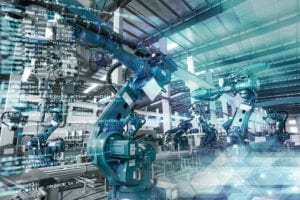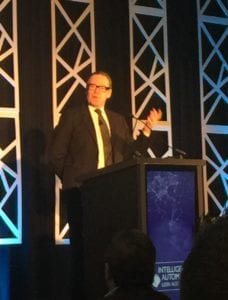 Intelligent Automation Week (Dec. 3–6; Austin, Tex.; https://intelligentautomationevent.iqpc.com/) brought together representatives from many varied industries to discuss practical applications for artificial intelligence (AI), robotic process automation (RPA), cognitive computing and more. Participating organizations included McDonald’s, the National Aeronautics and Space Administration (NASA), Pepsico, Wyndham Hotels & Resorts, General Motors and many more. Michael Rogers, a contributor to MSNBC and the New York Times, provided the event’s keynote address. He emphasized that it is imperative for organizations at any point in their digital journey to take stock of automation’s best use cases before assuming that all tasks can be automated. “A crucial task is to figure out what belongs in the virtual world and what still belongs in the real world and find ways to connect them,” said Rogers. Making these connections, he explained, will require many employees with the proper skillsets and, in many cases, the use of advanced “smart” objects, such as energy-harvesting sensors. He also advised automation decision-makers to evaluate which technologies may be overhyped in their respective industry sectors, and which technologies actually provide intelligent automation, contrasting the overall benefits provided by largely hyped autonomous vehicles with the safety-enhancing capabilities of smart sensors for roads and bridges. In a particularly fascinating use case for safety-improving smart devices, presenters from Walmart cited the implementation of chemical sensors to quickly determine product quality (for instance, spoiled food in warehouses and stores) as one of their in-development automation projects.
Intelligent Automation Week (Dec. 3–6; Austin, Tex.; https://intelligentautomationevent.iqpc.com/) brought together representatives from many varied industries to discuss practical applications for artificial intelligence (AI), robotic process automation (RPA), cognitive computing and more. Participating organizations included McDonald’s, the National Aeronautics and Space Administration (NASA), Pepsico, Wyndham Hotels & Resorts, General Motors and many more. Michael Rogers, a contributor to MSNBC and the New York Times, provided the event’s keynote address. He emphasized that it is imperative for organizations at any point in their digital journey to take stock of automation’s best use cases before assuming that all tasks can be automated. “A crucial task is to figure out what belongs in the virtual world and what still belongs in the real world and find ways to connect them,” said Rogers. Making these connections, he explained, will require many employees with the proper skillsets and, in many cases, the use of advanced “smart” objects, such as energy-harvesting sensors. He also advised automation decision-makers to evaluate which technologies may be overhyped in their respective industry sectors, and which technologies actually provide intelligent automation, contrasting the overall benefits provided by largely hyped autonomous vehicles with the safety-enhancing capabilities of smart sensors for roads and bridges. In a particularly fascinating use case for safety-improving smart devices, presenters from Walmart cited the implementation of chemical sensors to quickly determine product quality (for instance, spoiled food in warehouses and stores) as one of their in-development automation projects.

Michael Rogers
The critical role of industrial safety, and automation’s role in modernizing safety practices, took center stage at a presentation by Adel Aleaddini, a professor of mechanical engineering at the University of Texas San Antonio, and Krishnan Krishnaiyer, the director of enterprise business improvement at Marathon Petroleum Corp., entitled “Keep Humans Safe — Predicting Safety Incidents.” The presentation outlined a project to utilize text mining and predictive data analytics to develop insights from safety reports. Analyzing employee-submitted safety incident reports enabled the development of an advanced predictive model to categorize risks and better predict ways to mitigate future safety incidents.
Although automation is increasingly taking hold across nearly all industries, many operations are still quite dependent on paper. Panelists from Farmer’s Insurance, Bank of America and AIG discussed some best practices for introducing automation into paper-heavy organizations. A key point made by Manik Patil, global senior director of AIG, was that companies must first “build their AI muscle” and start out on smaller projects to prove capabilities and to help get more backing from stakeholders before tackling progressively larger automated projects. While building confidence in the organization, this tactic also helps to reduce risk earlier in the project and ensure that employees understand new strategies, explained Patil.
Lia Johnson, director of data & analytics digital technologies at Baker Hughes, a GE Company (BHGE), reiterated this point in a panel focused on employing AI to drive operational efficiency. At BHGE, starting with small projects and effectively communicating with personnel regarding adoption of AI helped to assuage employee uncertainty about digital technologies and job vulnerability. She reiterated that digital technologies are supplementing — rather than replacing — jobs, and by automating certain tasks, employees are now enabled to tackle more creative and strategic tasks. And while AI has provided benefits, it has also introduced new challenges in the form of governance, technology ownership and cybersecurity. However, Johnson insisted that these challenges are greatly outweighed by the gains an organization can realize with automation. “Driving costs down with automation has truly helped us leapfrog our competition,” she emphasized.

Lia Johnson
Looking ahead to the workforce of the future, where the humans and digital technologies will work side by side, Brad Shaink, the director of digital innovation & engagement technologies at Houston Methodist Hospital summed up intelligent automation succinctly: “With automation, the human workforce will transition from doing all the tasks to managing the exceptions.”